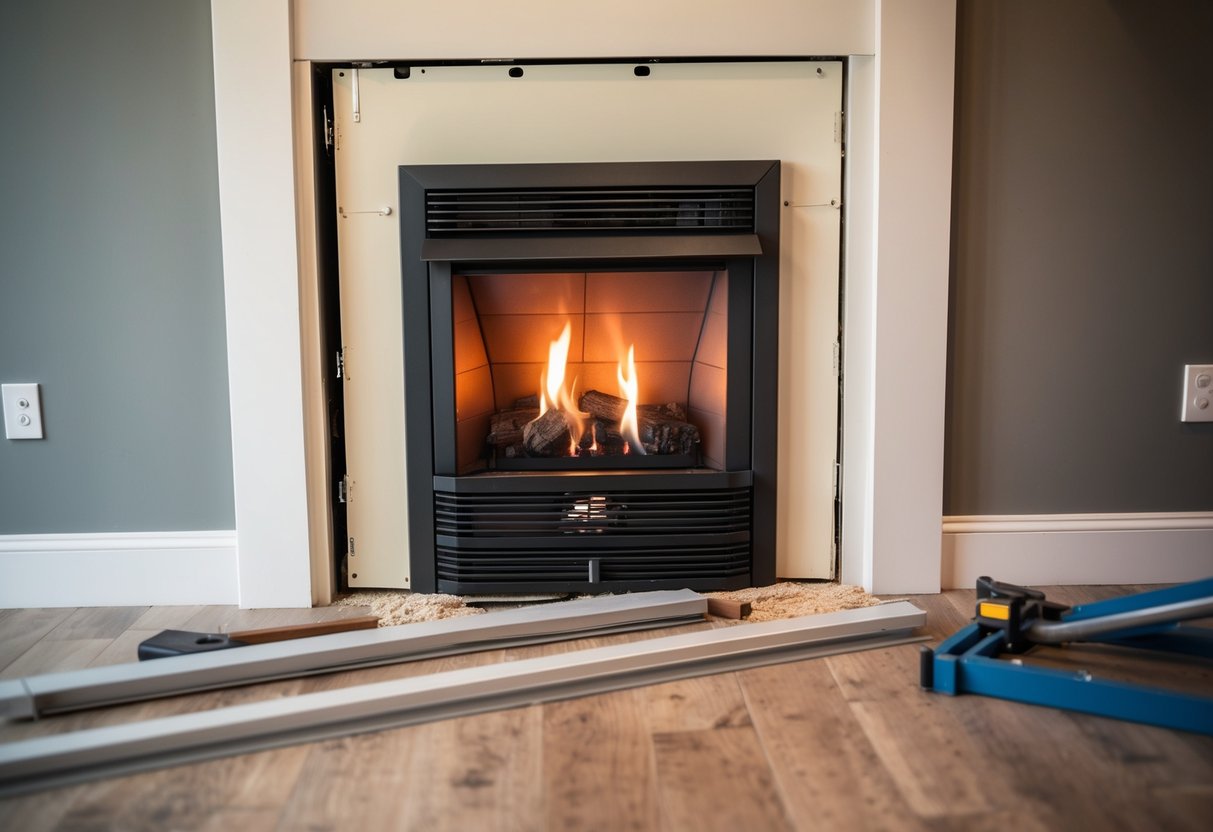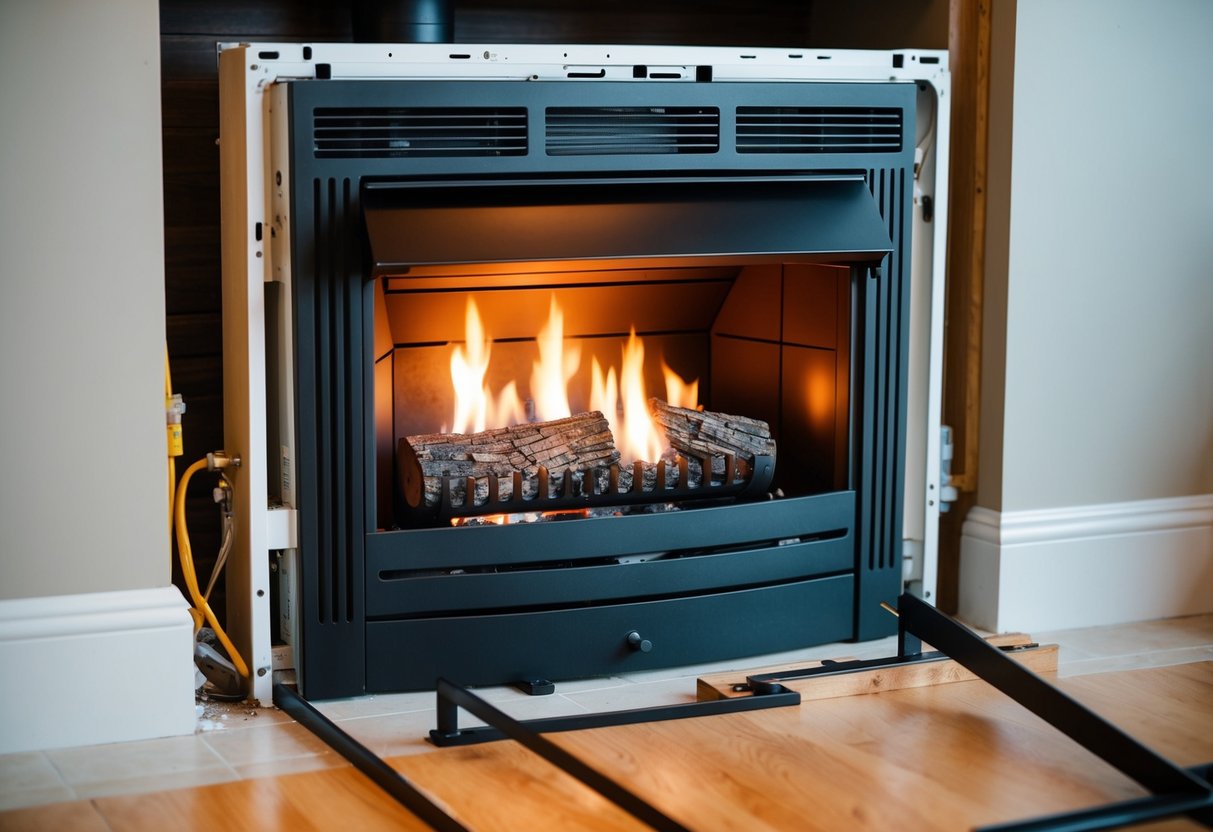Can Gas Fireplaces Be Converted to Wood?
Transforming a gas fireplace into a wood-burning one is a project that many homeowners consider for the cozier ambiance that wood fires provide. Yes, a gas fireplace can be converted to a wood-burning unit, but it involves significant modifications and costs. The process often requires the installation of a flue and chimney if they don’t already exist, and it can involve substantial structural changes.
Homeowners need to prepare for both the technical and financial aspects of the conversion. While the initial investment might seem steep, the authentic warmth and crackling sounds of a wood-burning fireplace can be rewarding for those who enjoy traditional fires. It’s important to weigh the factors such as conversion costs, ongoing maintenance needs, and potential increases in warmth and household atmosphere.
Before embarking on this project, potential converters should seek professional advice to ensure that all safety and building regulations are met. An understanding of all pre-conversion requirements and post-conversion maintenance ensures the remodeling process enhances, rather than complicates, their living space.
Key Takeaways
- Converting from gas to wood requires structural modifications.
- Professional guidance is essential for a successful installation.
- Wood fireplaces offer warmth and an authentic fire experience.
Understanding Fireplace Conversions

Converting a gas fireplace to a wood-burning one involves understanding the fundamental differences between the two types and assessing the existing structure for compatibility. Proper attention to these aspects ensures a successful and safe transition.
Difference Between Gas and Wood-Burning Fireplaces
Gas fireplaces are known for ease of use and require minimal cleanup. They often need no traditional chimney and are connected through vent systems that manage the combustion gases. In contrast, wood-burning fireplaces provide a more traditional experience with real flames and the aroma of burning wood.
A crucial difference lies in energy efficiency and heat output. Wood fireplaces typically boast a higher heat output efficiency, ranging from 58% to 82%. Gas fireplaces may only achieve around 20% efficiency. Additionally, safety is paramount as wood-burning options require a chimney to handle smoke and soot. The benefits of each type cater to different preferences and needs, making conversions a matter of personal or structural choice.
Assessing the Current Fireplace Structure
Evaluating the existing setup is essential before conversion. This includes checking the structural integrity and determining if a suitable chimney liner is present. A wood-burning fireplace demands a functional chimney for enhanced ventilation. If a chimney isn’t in place, it must be installed, which requires a significant remodeling effort.
The fireplace’s current material and design dictate the conversion process. Parts like gas lines must be safely closed by professionals. Consulting with specialists ensures safety standards are met, and it’s vital to understand any local regulatory requirements. Converting requires an assessment of labor and material costs, often amounting to a significant investment.
Pre-Conversion Considerations

Converting a gas fireplace to a wood-burning one involves several critical aspects. These include compliance with local building codes, ensuring safety and proper ventilation, and evaluating the requirements for removing or modifying the gas line.
Local Building Codes Compliance
When considering this conversion, checking local building codes is essential. These regulations differ widely by region and dictate specific requirements for fireplace installations. Homeowners must verify if a building permit is needed for the conversion.
Building codes will often outline the necessary chimney specifications and safety measures. Engaging with a licensed contractor familiar with local regulations can simplify this process. Neglecting these codes can lead to fines or safety hazards, so prioritizing compliance not only ensures legality but also safety.
Safety and Ventilation Requirements
Safety should never be compromised when converting a fireplace. Proper ventilation is crucial to ensure smoke and combustion gases exit the home safely. This typically involves installing or upgrading a chimney flue system to accommodate wood smoke.
It is vital to install a functioning carbon monoxide detector, which provides an essential safety layer against potential gas buildup. Proper ventilation protects residents from dangers such as smoke inhalation and carbon monoxide poisoning.
Evaluating the Gas Line Removal
Before using the fireplace for burning wood, it is crucial to address the existing gas line. The line must be properly capped or converted, often requiring professional services to avoid gas leaks.
There are options to repurpose the line, such as for a gas log lighter. Engaging a professional ensures that any work on the gas line adheres to safety standards. Cost and safety are significant considerations in this aspect, as improper handling can result in dangerous outcomes.
The Conversion Process

Converting a gas fireplace to a wood-burning setup involves several meticulous steps. It requires installing new components and making essential adjustments to the chimney and flue. Ensuring safety and efficiency is paramount throughout the transformation.
Installing Wood-Burning Components
Before any work begins, capping off the gas line is crucial to prevent leaks. It’s recommended to consult professionals for this task. The next step is selecting and installing a wood-burning insert. These inserts transform the existing gas setup into a wood-burning fireplace and come in a variety of styles, tailored to fit different fireplace sizes.
In addition to the insert, a fireplace damper should be installed if not already present. Dampers help manage airflow and enhance efficiency. It is advisable to choose inserts with high energy efficiency ratings to maximize heat output.
Chimney and Flue Adjustments
A critical step in the process is ensuring the chimney and flue are in optimal condition. For wood burning, a functional chimney and properly sized flue are mandatory to vent smoke and gases safely. If the existing flue is incompatible, modifications or replacements may be required.
Hiring a chimney sweep for inspection is a wise choice. They can evaluate the current setup and recommend necessary changes. Ensuring the chimney is clean and free of obstructions can prevent smoke backflow and other hazards.
Finalizing the Wood Fireplace Setup
Once components and chimney adjustments are made, testing the system is important. Begin with seasoned wood to ensure a clean, efficient burn. This type of wood minimizes creosote buildup, enhancing safety and performance.
Installing a spark guard or screen is a good practice to prevent embers from escaping into the living area. Regular maintenance checks and professional inspections ensure the fireplace runs smoothly over the long term. It’s essential to follow local building codes and safety standards during the entire process.
Post-Conversion Care and Maintenance

After converting a gas fireplace to a wood-burning one, proper maintenance ensures safe and efficient operation. Regular chimney cleaning, fireplace inspections, and use of safety equipment like fireplace screens are essential to prevent hazards.
Routine Chimney Cleaning and Inspection
Chimney cleaning is vital for maintaining a wood-burning fireplace. Creosote, a byproduct of burning wood, can accumulate and pose a fire risk if not removed. Annual cleaning is recommended to keep the chimney in optimal condition. It’s wise to hire a professional for thorough cleaning and inspection to identify any structural issues or blockages.
Regular inspections also help in ensuring that the chimney lining and firebox are free from cracks. Inspection should include checking the spark arrestor to prevent embers from escaping. Ensuring proper chimney insulation can also enhance efficiency by maintaining appropriate temperatures.
Operational Tips for Wood-Burning Fireplaces
For efficient and safe operation, maintaining a cozy fire is key. Always use dry, seasoned wood to ensure better heat output and less smoke. Installing a fireplace screen can prevent sparks from escaping into the room.
A properly installed smoke detector near the fireplace can provide an extra layer of safety by alerting users to potential smoke build-up. Regular testing of the smoke detector is recommended. Adhering to local building regulations when modifying fireplace structures ensures compliance and safety in operation.
To aid economical heating, ensuring good vertical chimney care is essential. This includes making sure that the chimney height and structure support efficient draft and ventilation.
Frequently Asked Questions
Converting a gas fireplace to wood involves several considerations, including safety and cost. It’s essential to understand the necessary steps and potential challenges before undertaking this conversion.
What are the necessary steps to convert a gas fireplace to a wood-burning one?
The conversion typically requires removing gas components, installing wood-burning elements, and ensuring proper chimney requirements. Assessing the existing fireplace and following safety guidelines is crucial. It’s often advisable to consult a professional to achieve the best results.
Is it possible to install a wood-burning fireplace where a gas unit exists without a chimney?
A chimney is essential for venting smoke and combustion gases. Without one, the installation of a wood-burning fireplace would not meet safety standards. Alternative venting solutions or chimney construction may be necessary.
How much typically does the conversion from a gas to a wood-burning fireplace cost?
Costs can vary significantly based on location and fireplace type. Generally, expenses might range from a few hundred to several thousand dollars. Consulting with professionals for accurate estimates tailored to specific requirements is recommended.
Are there specific conversion kits for changing a gas fireplace to wood-burning?
Conversion kits may be available, but using them requires precise installation and adherence to safety standards. It’s important to verify that any kit meets local building codes and is compatible with the existing fireplace structure.
What should be considered when looking to hire a professional for converting a gas fireplace to wood?
Hiring a professional ensures adherence to safety standards and proper conversion techniques. Checking credentials, experience, and references is important. It is beneficial to engage a certified technician familiar with local building codes.
Can a gas fireplace with a chimney be safely used to burn wood after conversion?
A gas fireplace with an existing chimney can potentially be converted to a wood-burning one. The chimney must be inspected and altered, if necessary, to accommodate wood-burning fireplace requirements. Proper maintenance ensures safe and efficient operation.



